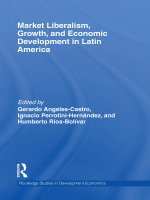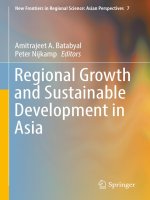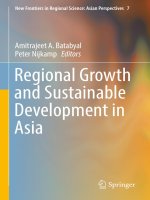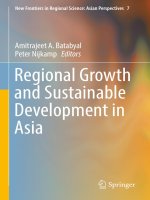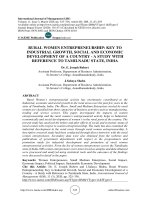Economic growth and economic development 27
Bạn đang xem bản rút gọn của tài liệu. Xem và tải ngay bản đầy đủ của tài liệu tại đây (44.52 KB, 1 trang )
Introduction to Modern Economic Growth
Figure 1.8 provides another look at these patterns by plotting log GDP per capita
for a number of countries between 1960 and 2000 (in this case, we look at GDP per
capita instead of GDP per worker both for data coverage and also to make the
figures more comparable to the historical figures we will look at below). At the top
of the figure, we see the US and the UK GDP per capita increasing at a steady pace,
with a slightly faster growth for the United States, so that the log (“proportional”)
gap between the two countries is larger in 2000 than it is in 1960. Spain starts
much poorer than the United States and the UK in 1960, but grows very rapidly
between 1960 and the mid-1970s, thus closing the gap between itself and the United
States and the UK. The three countries that show very rapid growth in this figure
are Singapore, South Korea and Botswana. Singapore starts much poorer than the
UK and Spain in 1960, but grows very rapidly and by the mid-1990s it has become
richer than both (as well as all other countries in this picture except the United
States). South Korea has a similar trajectory, but starts out poorer than Singapore
and grows slightly less rapidly overall, so that by the end of the sample it is still
a little poorer than Spain. The other country that has grown very rapidly is the
“African success story” Botswana, which was extremely poor at the beginning of
the sample. Its rapid growth, especially after 1970, has taken Botswana to the ranks
of the middle-income countries by 2000.
The two Latin American countries in this picture, Brazil and Guatemala, illustrate the often-discussed Latin American economic malaise of the postwar era.
Brazil starts out richer than Singapore, South Korea and Botswana, and has a relatively rapid growth rate between 1960 and 1980. But it experiences stagnation from
1980 onwards, so that by the end of the sample all three of these countries have
become richer than Brazil. Guatemala’s experience is similar, but even more bleak.
Contrary to Brazil, there is little growth in Guatemala between 1960 and 1980, and
no growth between 1980 and 2000.
Finally, Nigeria and India start out at similar levels of income per capita as
Botswana, but experience little growth until the 1980s. Starting in 1980, the Indian
economy experiences relatively rapid growth, but this has not been sufficient for
its income per capita to catch up with the other nations in the figure. Nigeria, on
the other hand, in a pattern all-too-familiar in sub-Saharan Africa, experiences a
13
